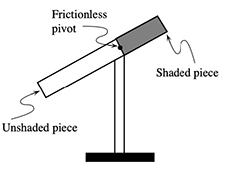
Equilibrium of rigid bodies
Variant i Dynamics first
Developed by Luanna Gomez-Ortiz (co-creator), Paula Heron (co-creator), and Peter Shaffer (contributor)
The tutorial covers the ideas of the conditions of equilibrium, center of mass, and extended free- body diagrams (diagrams showing forces and the location at which each force can be taken to act). The context is balancing.
Topics Mechanics / Rotation
Materials
Materials by the UW team
- Equipment List

- Instructor’s Guide


- Sample Pre-test


- Sample Exam Questions



Tutorial details
A major focus of this tutorial is on helping students learn how the variables mass and mass distribution affect balancing. In the first section of the tutorial, students are guided to make the proper observations about the motion of a rigid body pivoted at its center of mass and to relate these observations to the conditions of equilibrium. The students are asked to make a prediction about the motion of an irregularly shaped board that is placed on a frictionless pivot at its center of mass. After they have observed the demonstration, the students are guided through a set of experiments in which they hang the object from a point other than its center of mass and balance with a piece of clay. Through these exercises, students generalize how mass on either side of the pivot influences balancing.
Later in the tutorial, students are asked to compare the amount of mass on the left to that on the right of the vertical line through the center of mass of the board alone. Students are asked to check to see if their prediction is consistent with their generalizations about mass. This question is meant to help students recognize that the amount of mass of the two pieces of the board could differ and the board could still balance as they previously observed.
For instruction tips, login or register as a verified educator to see the Instructor Guide.
Prerequisites
Students should already have been introduced to the topics of center of mass (of both continuous uniform mass distributions and of systems of single particles) and the conditions of equilibrium.
Equipment
Special Instructions

List
- white board or large sheet of paper with markers
- clay
- T-shaped board with axis and stand
Research
- L. Ortiz, P. Heron, and P. Shaffer, Student understanding of static equilibrium: Predicting and accounting for balancing, Am. J. Phys. 73 (6), 545 (2005).
Coming Soon! We hope to release the discussion section on each tutorial by the end of July 2024.

